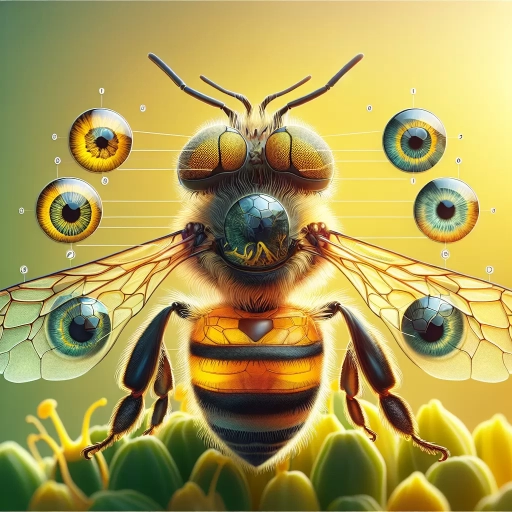How Many Eyes Does A Bee Have

Understanding The Unique Vision of Bees
Importance of a Bee's Vision
The vision of bees plays a crucial role in their survival, foraging, and pollination activities. Bees have one of the most complex visual systems in the insect world, which allows them to navigate their environment efficiently. Their vision enables them to identify flowers, avoid obstacles, and return to their hive. Moreover, their ability to see ultraviolet light – something humans can’t do – allows them to spot patterns on flowers that are invisible to us. These patterns often lead to the nectar source, making foraging more efficient.
Structure of a Bee's Eye
Bee's eyes are not like human eyes. They have compound eyes, which comprise thousands of tiny lenses called ommatidia. Each ommatidia captures a small part of the bee's field of view, and the bee's brain combines these individual images to form a mosaic-like picture of its surroundings. These eyes are particularly good at detecting movement, which is crucial for bees as they fly at high speeds and need to avoid collisions. Furthermore, the structure of a bee's eye allows it to see in almost every direction at once.
Number of Eyes on a Bee
To an unsuspecting observer, it may appear that a bee has two eyes - just like humans. But upon closer look, you will notice that bees actually have five eyes. Two large compound eyes, one on each side, and three smaller ocelli (simple eyes) on top of its head. The compound eyes are largely used for navigation, foraging, and detecting motion, while the ocelli are primarily used to sense light intensity and help maintain orientation towards the sun.
Exploring The Detailed Anatomy of Bee's Eyes
Anatomy of the Compound Eyes
The compound eyes of bees are made up of thousands of hexagonal units called ommatidia. Each ommatidium consists of a lens, a cone, visual cells (or photoreceptor cells), and pigment cells. The lens focuses light onto the photoreceptor cells, which then convert the light into electrical signals that the bee's brain can interpret. These eyes allow bees to see a wide field of view and detect movements and polarized light patterns from the sun, which bees use for navigation.
Anatomy of the Ocelli
The three ocelli are located on the top of the bee's head in a triangular formation. Unlike the compound eyes, the ocelli do not form detailed images. Instead, they are sensitive to changes in light intensity, and they help the bee maintain its orientation towards the sun. The ocelli can perceive the polarization of sunlight, which remains relatively constant throughout the day, allowing bees to stay oriented even when the sun is obscured by clouds.
Bee's Ultraviolet Vision
One remarkable feature of a bee's vision is its ability to see ultraviolet light. While humans see light in combinations of three colours - red, green, and blue, bees see light in combinations of ultraviolet, blue, and green. This UV vision helps bees identify flower patterns, known as nectar guides, that indicate where the nectar is located. These nectar guides are invisible to humans, revealing a covert world of communication between flowers and bees.
The Role Bees Play in the Ecosystem and The Importance of Their Vision
Bee Pollination and Ecosystems
Bees are vital pollinators and their work has a profound impact on ecosystems. They play a major role in the reproduction of many plant species. When a bee lands on a flower to collect nectar, pollen grains stick to the bee's hairy body and are then carried to the next flower the bee visits. This pollination process is necessary for the production of seeds in many plants. Without bees, many of our favourite fruits and vegetables would become much rarer and more expensive.
The Impact of a Bee's Vision on Pollination
A bee's complex visual system is instrumental in its role as a pollinator. The bee's ability to see ultraviolet light and detect polarized light patterns, combined with its wide field of view and high-speed motion detection, helps it find and recognize flowers. After all, bees can perceive flower colors and patterns that are invisible to human eyes. Thus, their unique vision allows them to efficiently harvest nectar and pollen, leading to successful pollination.
Threats to Bee Vision and Pollination
Unfortunately, factors such as climate change, habitat loss, and pesticide use pose significant threats to bees and their vision. Changes in temperature can affect flowering times, making it difficult for bees to find nectar and pollen. Pesticides can also impair bees' vision, navigation skills, and foraging efficiency. Ensuring the health and survival of bees and protecting their vision is crucial for maintaining diverse and abundant plant life on our planet. Therefore, it’s necessary to reduce the use of harmful pesticides and to plant bee-friendly flowers and plants to provide food and habitat for bees.